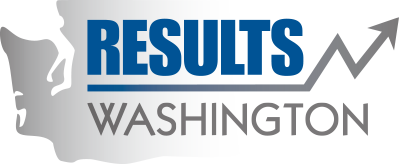Archived: Strategic Corridor Efficiency
Data source: Washington State Department of Transportation
The top graph displays the throughput productivity percentages during the daytime travel period averaged across 20 different locations on strategic corridors. Throughput productivity is defined as the efficiency of a highway segment, expressed as a percentage of the maximum throughput recorded at that particular highway location. Maximum throughput is a dynamic metric of when highways are operating at peak efficiency, typically occurring when vehicles travel at speeds between 70-85% of a posted speed and drivers feel more comfortable traveling with less space between vehicles. The bottom graph shows the throughput productivity averages for morning and afternoon peak periods (5-10 a.m. and 2-8 p.m., respectively). An increase in throughput productivity on the graph indicates that system efficiency has improved, meaning more people and/or goods are being moved per corridor mile. More information on how throughput productivity is calculated can be accessed in the following background document.
NO INFORMATION
Maintaining state highway system performance for people and freight movement is important to the region's economic vitality. Commuters value efficiency across all transportation modes because it allows them to make better use of their own time, while shippers and freight carriers require an efficient system to remain competitive. By tracking throughput productivity, WSDOT can monitor and prioritize efficiency needs.
For 2015, WSDOT met the goal of operating strategic corridors at 90% efficiency or higher. System efficiency for 2015 was 93.4%, showing a decrease of 1.2 percentage points from 94.6% efficiency in 2014. System efficiency has been worsening overall since 2009, which follows the overall trend of economic growth since the Great Recession. Throughput productivity is impacted by economic activity because increased people and freight movement often means more traffic on the roads. Throughput productivity data shows the best system performance during daytime hours in 2009, which corresponds with the reduced traffic and decline in economic activity during the Great Recession. State highway capacity remains above the 90% efficiency goal, but has declined overall during the economic recovery period since 2009.
Practical solutions: WSDOT is actively implementing Practical Solutions, a two-part strategy that includes Least Cost Planning initiatives and Practical Design, which enables more flexible and sustainable transportation investment decisions. This includes initiatives to improve person throughput and trip reliability. Using Practical Solutions principles, planners and engineers can develop solutions specific to a performance goal (such as travel time reliability and improved throughput) that are strategic and incremental without compromising safety. This approach allows the focus to remain on project need and how it will help meet the core transportation needs, without excessively addressing other performance categories. WSDOT has used elements of practical design over the years to address the need for a project while identifying cost-effective solutions. For more information on WSDOT’s Practical Solutions overview, examples, and FAQs, please visit http://www.wsdot.wa.gov/Projects/PracticalDesign/
Transportation options: WSDOT is working closely with cities and counties, transit agencies, planning organizations, businesses and other stake holder communities to promote multimodal transportation options. This would emphasize walking, biking, transit, ride share, carpools, teleworking to name a few. Providing diverse options for commuters and connecting alternative mode networks can enable capacity on the regional system to improve throughput and travel time reliability.
Tolling and HOT lanes: WSDOT is integrating tolling as a strategic tool to help manage traffic more efficiently, fund public improvement projects, and generate revenue required for ongoing operational costs of existing facilities. WSDOT currently tolls the SR 520 Bridge, Tacoma Narrows Bridge, SR 167 HOT lanes, and I-405 Express Toll Lanes. Express toll lanes and HOT lanes benefit transit, vanpools, carpools, and motorcycles with more reliability and give other drivers the new option to pay a toll to access a faster trip. Toll lanes save people time, improve lane performance, and help move more people and vehicles through a corridor at peak hours. Dynamic pricing is used on the SR 167 HOT lanes and I-405 Express Toll Lanes. A computer algorithm changes the toll rate in response to traffic volumes and speeds, increasing the toll rate during congestion in order to manage traffic volume and keep traffic moving.
For additional information about throughput productivity, system capacity and other multimodal analyses of state highway system performance, see the following publications:
2016 Corridor Capacity Report, available at http://wsdot.wa.gov/publications/fulltext/graynotebook/CCR16.pdf
2016 Corridor Capacity Appendix, available at http://wsdot.wa.gov/publications/fulltext/graynotebook/CCR16_appendix.pdf
WSDOT's Handbook for Corridor Capacity Evaluation, available at http://wsdot.wa.gov/publications/fulltext/graynotebook/CCR_methodology_2nd_edition.pdf
Reported by: Washington State Department of Transportation
NO INFORMATION
